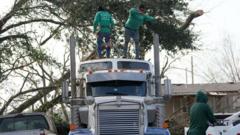At least four individuals lost their lives as a series of tornadoes wreaked havoc across the southern United States. Reports indicate that nearly 40 tornadoes were confirmed between Saturday and Sunday, impacting states including Texas, North Carolina, Louisiana, Georgia, and Arkansas. The violent storms resulted in substantial property damage and widespread power outages, affecting tens of thousands of residents.
Mississippi experienced two fatalities, with one victim identified in Adams County, about 92 miles west of Jackson, and another in Lowndes County, near the Alabama border. Additionally, a 70-year-old man in North Carolina, Matthew Ronald Teeple, died after a tree fell on his vehicle. In Texas' Brazoria County, a 48-year-old woman lost her life, while four others sustained non-critical injuries amid the destruction caused by tornadoes with wind speeds reaching up to 145mph.
The National Weather Service (NWS) highlights the average occurrence of approximately 800 tornadoes in the United States each year, which typically account for about 80 deaths. This year, however, has recorded a staggering 1,762 tornado incidents between January and November, marking the highest number since 2011.
In terms of impact, Mississippi faced significant challenges as power outages affected around 32,000 residents—down from about 100,000 since the storms hit. In Montgomery County, Texas, the tornadoes damaged approximately 300 buildings, destroying 30 structures completely, as officials issued a rare "particularly dangerous situation" tornado watch.
As communities begin the recovery process from the devastation, officials will likely reassess safety protocols and emergency preparedness in light of the rising frequency and intensity of severe weather events.






















